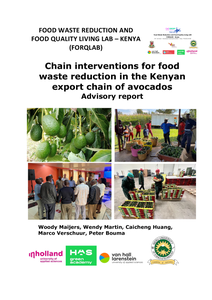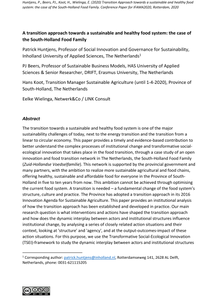An important contribution to the environmental impact of agro-food supply chains is related to the agricultural technology and practices used in the fields during raw material production. This problem can be framed from the point of view of the Focal Company (FC) as a raw material Green Supplier Selection Problem (GSSP). This paper describes an extension of the GSSP methodology that integrates life cycle assessment, environmental collaborations, and contract farming in order to gain social and environmental benefits. In this approach, risk and gains are shared by both parties, as well as information related to agricultural practices through which the FC can optimize global performance by deciding which suppliers to contract, capacity and which practices to use at each supplying field in order to optimize economic performance and environmental impact. The FC provides the knowledge and technology needed by the supplier to reach these objectives via a contract farming scheme. A case study is developed in order to illustrate and a step-by-step methodology is described. A multi-objective optimization strategy based on Genetic Algorithms linked to a MCDM approach to the solution selection step is proposed. Scenarios of optimization of the selection process are studied to demonstrate the potential improvement gains in performance.
DOCUMENT
This open access book states that the endemic societal faultlines of our times are deeply intertwined and that they confront us with challenges affecting the security and sustainability of our societies. It states that new ways of inhabiting and cultivating our planet are needed to keep it healthy for future generations. This requires a fundamental shift from the current anthropocentric and economic growth-oriented social contract to a more ecocentric and regenerative natural social contract. The author posits that in a natural social contract, society cannot rely on the market or state alone for solutions to grand societal challenges, nor leave them to individual responsibility. Rather, these problems need to be solved through transformative social-ecological innovation (TSEI), which involves systemic changes that affect sustainability, health and justice. The TSEI framework presented in this book helps to diagnose and advance innovation and change across sectors and disciplines, and at different levels of governance. It identifies intervention points and helps formulate sustainable solutions for policymakers, administrators, concerned citizens and professionals in moving towards a more just and equitable society.
MULTIFILE

VHL University of Applied Sciences (VHL) is a sustainable University of AppliedSciences that trains students to be ambitious, innovative professionals andcarries out applied research to make a significant contribution to asustainable world. Together with partners from the field, they contribute to innovative and sustainable developments through research and knowledge valorisation. Their focus is on circular agriculture, water, healthy food & nutrition, soil and biodiversity – themes that are developed within research lines in the variousapplied research groups. These themes address the challenges that are part ofthe international sustainability agenda for 2030: the sustainable developmentgoals (SDGs). This booklet contains fascinating and representative examplesof projects – completed or ongoing, from home and abroad – that are linked tothe SDGs. The project results contribute not only to the SDGs but to their teaching as well.
DOCUMENT

Op basis van een uitgebreide literatuurstudie, 25 interviews met gebiedspartijen in Midden-Delfland en een aantal multi-stakeholders workshops is in kaart gebracht hoe een gebiedsgerichte aanpak gericht op landschapinclusieve kringlooplandbouw in Midden-Delfland vorm krijgt dan wel versterkt kan worden. Hiervoor is de Transitiebloem-aanpak (TBA) gebruikt als holistische, transdisciplinaire en praktijkgerichte transitiebenadering. Deze benadering helpt gebiedspartijen bij het realiseren van een integrale systeemaanpak en collectief handelingsperspectief gericht op de samenhang van verschillende gebiedsopgaven met betrekking tot landbouw, water, voedsel, bodem, biodiversiteit, energie, klimaat, erfgoed, stadplattelandrelaties en economie.
DOCUMENT

Bedrijfsovernames binnen de agrarische sector zijn complexe processen. Vooralsnog wordt er veel aandacht besteed aan het financiele, juridische en fiscale aspect, maar het sociaal-emotionele vlak blijft nog te vaak onderbelicht, terwijl dat juist een cruciale rol speelt. Vanuit culturele antropologie geven we in dit essay antwoord op de vraag: “hoe kom je tot een succesvolle bedrijfsovername op sociaal-emotioneel vlak?”
DOCUMENT
This booklet presents sixteen 'practice briefs' which are popular publications based on 12 Master and one Bachelor theses of Van Hall Larenstein University of Applied Sciences (VHL). All theses were commissioned through the research project entitled 'Inclusive and climate smart business models in Ethiopian and Kenyan dairy value chains (CSDEK)'. The objective of this research is to identify scalable, climate smart dairy business models in the context of the ongoing transformation from informal to formal dairy chains in Kenya and Ethiopia.
DOCUMENT

This publication the avocado advisory report which is based on popular papers (practice briefs) of master and bachelor theses and business assignments of students at three Dutch Universities of Applied Sciences: Van Hall Larenstein (VHL), InHolland and HAS Green Academy, and Meru University of Science and Technology in Kenya. All 23 theses and business assignments were commissioned through the research project entitled “Food Waste Reduction and Food Quality LivingLab (FORQLAB)” in Kenya.
DOCUMENT

The current western agrifood system is highly successful in providing for human needs. However, the dominant agricultural approach of up-scaling and specialisation is put under pressure by a number of developments in the global landscape. Global developments such as population growth, pollution, soil degradation and climate change, in which agriculture plays a crucial role, make the need for a transition towards a paradigm with a broader range of values evident. Niche initiatives often develop as a reaction to needs not fulfilled by the regime. Therefore, certain niches may have the potential of driving a necessary transition. This research aims to determine if permaculture, being a niche, has this potential. The main question for this research was formulated as follows: How can a production system based on permaculture principles contribute to the agrifood transition? To answer this question, relevant current trends and global developments were used as a basis for developing a future scenario. Empirical qualitative data on permaculture businesses in the Netherlands was gathered as well, of which the results were used for a determination of permaculture’s performance in this future scenario. This was done by comparing a standardised permaculture system with a conventional potato system. As a result of this comparison, the Unique Selling Points of permaculture were identified, which determine the future potential of permaculture.
DOCUMENT

From the article: "This article evaluates the application of blockchain technology to improve organic or fair-trade food traceability from “Farm to Fork” in light of European regulations. This study aims to shed light on the challenges in the organic food chain to overcome, the drivers for blockchain technology, and the challenges in current projects."
DOCUMENT

The transition towards a sustainable and healthy food system is one of the major sustainability challenges of today, next to the energy transition and the transition from a linear to circular economy. This paper provides a timely and evidence-based contribution to better understand the complex processes of institutional change and transformative social-ecological innovation that takes place in the food transition, through a case study of an open innovation and food transition network in The Netherlands, the South-Holland Food Family (Zuid-Hollandse Voedselfamilie). This network is supported by the provincial government and many partners, with the ambition to realize more sustainable agricultural and food chains, offering healthy, sustainable and affordable food for everyone in the Province of South-Holland in five to ten years from now. This ambition cannot be achieved through optimising the current food system. A transition is needed – a fundamental change of the food system’s structure, culture and practice. The Province has adopted a transition approach in its 2016 Innovation Agenda for Sustainable Agriculture. This paper provides an institutional analysis of how the transition approach has been established and developed in practice. Our main research question is what interventions and actions have shaped the transition approach and how does the dynamic interplay between actors and institutional structures influence institutional change, by analysing a series of closely related action situations and their context, looking at 'structure' and 'agency', and at the output-outcomes-impact of these action situations. For this purpose, we use the Transformative Social-Ecological Innovation (TSEI)-framework to study the dynamic interplay between actors and institutional structures influencing institutional change. The example of TSEI-framework application in this paper shows when and how local agents change the institutional context itself, which provides relevant insights on institutional work and the mutually constitutive nature of structure and agency. Above institutional analysis also shows the pivotal role of a number of actors, such as network facilitators and provincial minister, and their capability and skills to combine formal and informal institutional environments and logics and mobilize resources, thereby legitimizing and supporting the change effort. The results are indicative of the importance of institutional structures as both facilitating (i.e., the province’s policies) and limiting (e.g. land ownership) transition dynamics.
DOCUMENT
